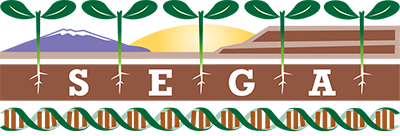You are here
I’m Lichen It! … a new hands-on science project for grades K6 thru’ K12 kicks off at SEGA sites and a schoolyard.

Susan Brown, a teacher from Northland Preparatory Academy and Kris Haskins of The Arboretum at Flagstaff have just finished getting their field materials in place for ‘I’m Lichen it!’ – a project looking at climate change through the lens of lichens. An intriguing symbioses between algae and fungi, lichens have been used as a means of aging the rocks they’re found growing on, as well as bio-indicators of pollution for many decades.
But in this study the question is “How does climate change affect lichen growth and diversity?”
Although the term ‘climate change’ may be a familiar word, in this project students from grades 6 thru’ 12 participate in hands-on data collection and analysis – forging a personal connection with what that term means. In tracking lichen responses, students will make their own observations and come to their own conclusions about climate change and its effects. And the elevation gradient and varying climatic conditions at 3 SEGA sites with different elevations are being used as a surrogate for the drying and warming predicted to affect the US southwest.
Lichen plots have been established at SEGA sites at Walnut Creek (a lower elevation pinyon juniper site north of Prescott), The Arboretum at Flagstaff (a medium elevation meadow) and Bear Springs (a high elevation site on the North Rim). An additional lichen garden on campus at Northland Preparatory Academy in Flagstaff has been set up as the “practice” garden. At each of the 3 SEGA locations at total of 35 rocks hosting lichen have been based on similar size and substrate geology. The rocks from each site have been randomly divided into groups – one left on its parent site – while the others have been taken to the two other SEGA sites and NPA. With 30 lichen-covered rocks in each of these ‘lichen gardens’ they’re being monitored over the next 10 years for the size of individual lichens (via tracings/photographs), numbers (counts), and apparent diversity (based on physical description).
The lichens at all 3 sites are being monitored annually (lichens grow slowly - around 1 – 3 mm per year) with photographic analysis of individual lichens and lichen colonies. This lets students learn how to use a grid system to track yearly growth - as well how to observe color to ascertain overall health of the colonies. They are also monitoring local weather conditions and comparing lichen growth with the weather data.
Each grade level is getting the opportunity to utilize the gardens and the data in slightly different ways:
6th grade – accurate and precise measurements, climate change
7th grade – balanced ecosystem, bio-indicators, human impact
8th grade – symbiotic relationships, adaptations, genetics
9th – 12th grades – environmental education, genetics, biology, climate change
Over the next ten years around 1500 students will participate in the study – and there’ll also be public outreach with displays of the student’s work to 25,000+ annual visitors at The Arboretum. So watch this space for results of these budding high school scientists!
Theme by Danetsoft and Danang Probo Sayekti inspired by Maksimer
